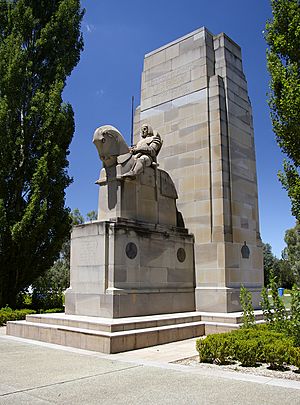King George V Memorial facts for kids
The King George V Memorial is a special monument found outside Old Parliament House, Canberra. It was planned in 1936 to honor King George V. Most of it was finished by 1941. However, it wasn't officially shown to the public until 1953. This delay happened because of World War II. The memorial was moved to its current spot in 1968.
Contents
Remembering King George V
Why the Memorial Was Built
The Australian Government decided to build this memorial in 1936. It was made to remember King George V. He was Australia's head of state from 1910 until he passed away in 1936.
Designing the Monument
The government asked artists to submit ideas for the memorial. A design by sculptor Rayner Hoff and architect Harry Foskett was chosen. Sadly, Hoff died in 1937 before the work started. John E Moorfield then took over to finish the memorial using Hoff's plans.
Two Sides of the Memorial
The memorial has two main parts. One side features a bronze statue of King George V. This part honors his time as king and Australia's history.
The other side has a stone statue of Saint George on a horse. This part remembers King George V's leadership during World War I. It also honors Australia's efforts in that war. The Museum of Australian Democracy explains that it's both a royal and a war memorial.
Delays and Unveiling
The memorial was mostly ready by 1941. But World War II caused big delays. The statue of King George V and other bronze parts couldn't be sent to Australia. They finally arrived in 1952. The King George V Memorial was officially shown to the public on March 4, 1953.
Moving the Memorial
Its First Location
The memorial was first placed right in front of Parliament House. The King George V statue faced the Parliament. The Saint George statue faced the Australian War Memorial. The designers, Hoff and Foskett, actually wanted it in a different spot. They thought it blocked the view.
Why It Was Moved
In 1968, the memorial was moved to its current location. This was done so it would no longer block the view of the Australian War Memorial from Parliament House. Politicians at the time felt it wasn't the best statue. They thought it spoiled the view.
The Memorial Today
Protecting Its History
Since 2004, the King George V Memorial has been listed as a heritage site. This means it's an important historical place. In 2015, it was restored. This work cost $326,000.
A Popular Spot
The memorial has been a popular place for people in Canberra. It was often used as a meeting point. It was also a favorite spot for skateboarders. Some international pro skate teams even featured it in their videos.
Recent Discussions
In 2020, some Indigenous Australian residents suggested moving the memorial again. They felt it was not appropriate to have a British Empire monument so close to the Aboriginal Tent Embassy.


